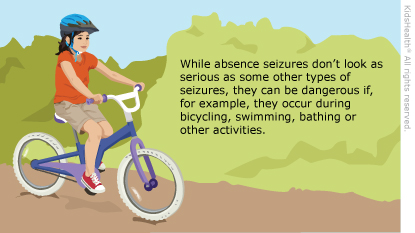Children who have absence seizures look like they are staring into space. They may open and close their lips loudly or make chewing motions, rub their fingers together, or flutter their eyelids. After the seizure, the child has no memory of the seizure.
Many children outgrow absence seizures in their teens. A neurologist (a doctor who specializes in problems of the brain and spinal cord) can help find what treatment, if any, is needed.



Your child:

Your child:

What causes absence seizures? Many times, the cause of absence seizures is not known. Sometimes seizures are from genetic changes. Children with absence seizures usually have a relative who has seizures too.
How can parents help their child get the best treatment? Be sure your child follows the health care provider's recommendations. If your child has another seizure, keep a record of:
This information will help the health care provider find the best treatment for your child's seizures.
How can parents help? Reassure your child that they're not alone. Many people have seizures. Your health care provider can answer questions and offer support. They also might be able to recommend a local support group. Online organizations can help too, such as: